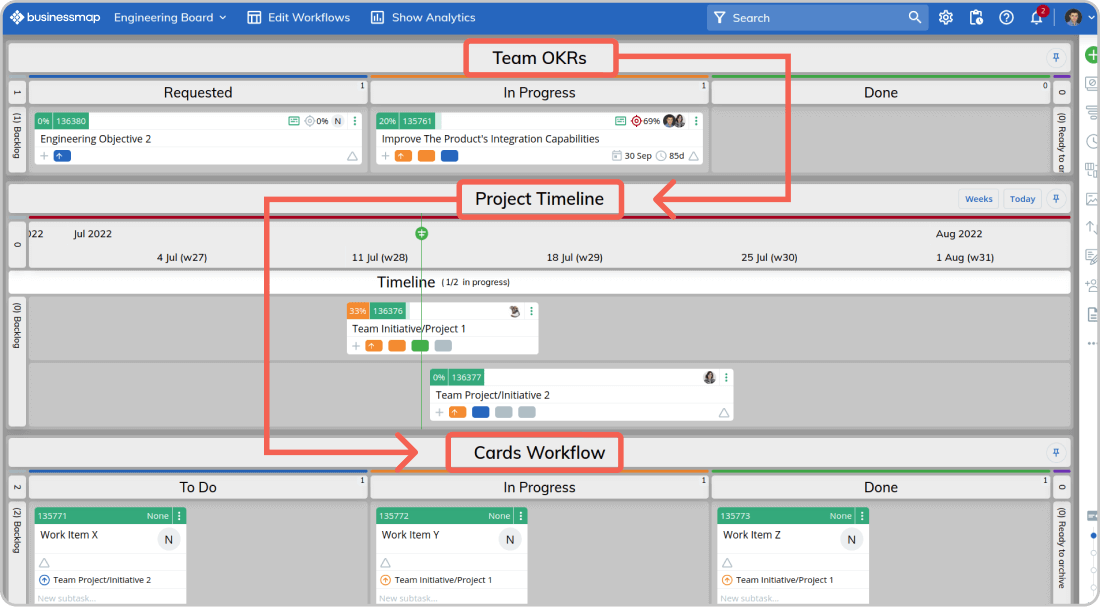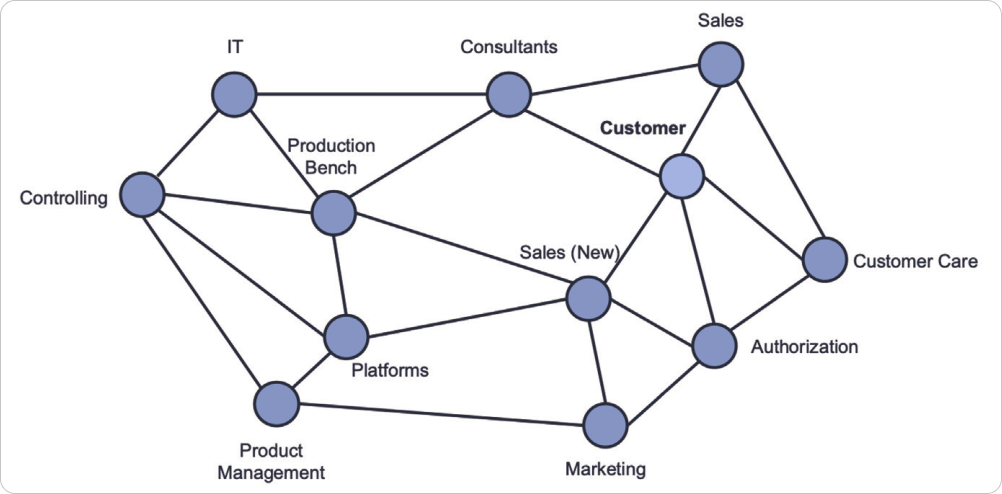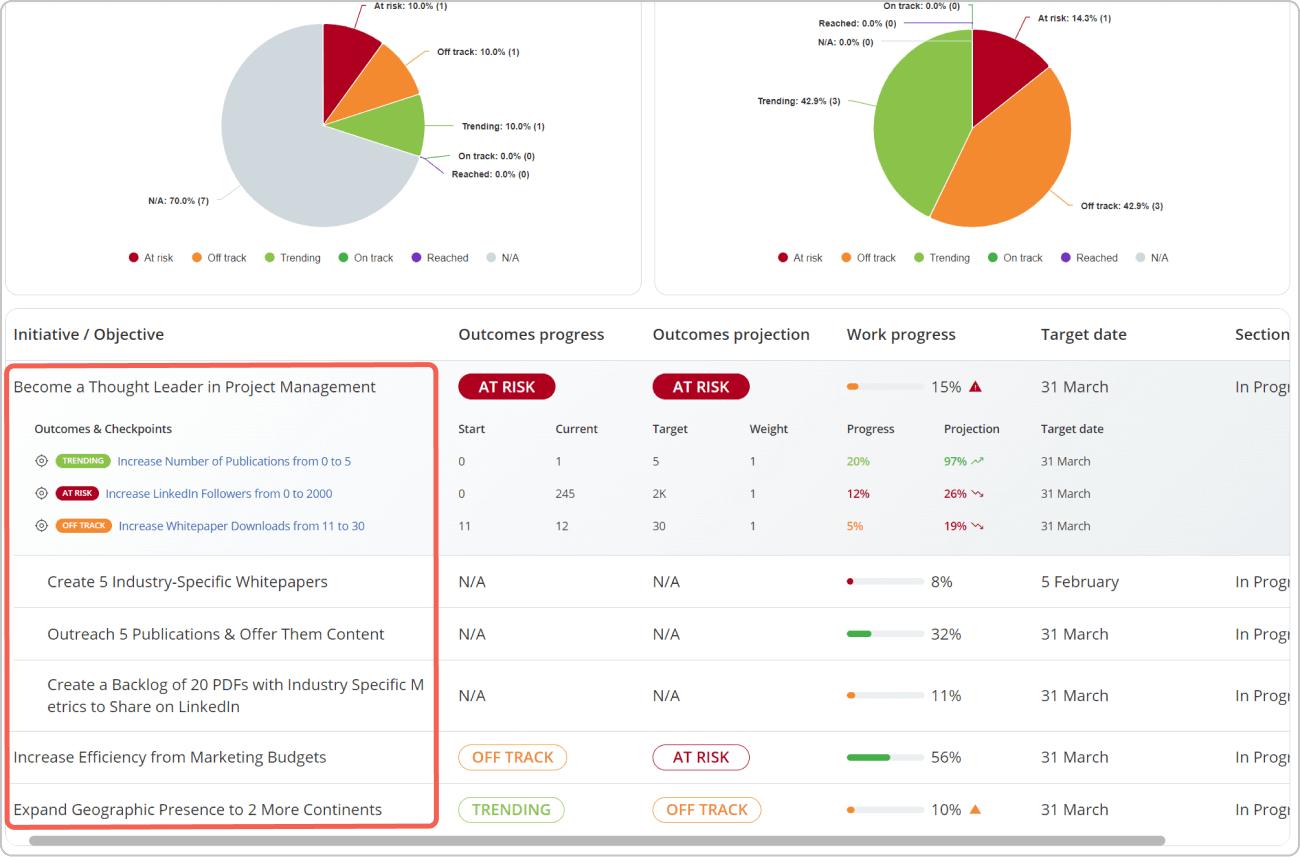We often think of a strategy like climbing a mountain: we know the destination (the peak), so the path seems clear. But what if reaching the top isn't the only goal?
Imagine a different scenario: we need to deliver food across a valley, not people. Building a massive bridge (like climbing a giant mountain) might seem the answer. However, it ignores crucial details. A smaller bridge or even a hot air balloon (alternative strategy) would be more efficient.
This is how focusing solely on the big picture can lead us astray. Strategy needs details - the "why" and "how" behind reaching the goal. Without them, we risk making bad decisions and building a bridge to nowhere.
8 Most Common Challenges of Strategy Execution
Well-crafted strategies that fall flat due to poor execution are an all-too-common problem. It's no coincidence that only 35% of executives believe their strategy will lead their company to success. Let's explore some of the pitfalls and uncover what's holding these strategies back.
1. Not Clearly Articulating Your Strategy
Bridging the gap between strategy formation and execution is a major leadership challenge. Shockingly, 4 out of 5 executives admit their overall strategy isn't well understood within their company. The key to success lies in aligning the company's values with coherent actions and fostering the right culture and capabilities. This alignment paves the way for seamless strategy implementation and drives organizations forward.
"Clearly communicate your vision and strategy to others."
Sophie Berninger, CEO of Bosch Advanced Ceramics, source: Strategy&
2. Missing Leadership Capabilities
Today's leaders must embody the traits of a "strategic executor" to drive their companies toward future success. Yet, half of top leaders lack proficiency in these crucial attributes, and 2 out of 3 CEOs admit they lack the capabilities needed to create value. In the digital era, successful strategy execution demands a disruptive leadership approach. Paul Leinwand, author of "Strategy that Works," and "Beyond Digital," emphasizes that effective strategies start by answering the right questions: "What is your goal?", "What unique value do you add?" and "What capabilities do you need to deliver on your value proposition?".
3. Lack of Critical Capabilities and Knowledge
To build and maintain excellence, organizations must attract and retain the right people, empowering them to grow and share their knowledge. For instance, the project manager's profession is already experiencing a recruitment gap, and essential capabilities like relationship building, strategic thinking, and collaborative leadership are becoming tough to find. As noted in the Narrowing the Talent Gap research, if capability-building isn't prioritized as a key driver of successful strategy execution, organizations will struggle to meet their goals.
4. Taking a Top-Down Approach to Execution
Moving fast is crucial for organizations but can be problematic when the strategy isn't well understood. The process involves breaking down challenges and identifying opportunities, but decisions are often made top-down instead of involving the execution team. Lean and Agile advocate Karl Scotland argues that while leadership defines the strategy, the people implementing it should determine how to meet those goals. This approach ensures that problems are resolved quickly and effectively.
5. Focusing on Execution Errors instead of the Environment
Spotting mistakes in execution is easy, but it often distracts management from the real issues in the environment or decision-making process. It's crucial to understand the work environment where people operate. When decision-making is too centralized, and teams aren't empowered, that creates a dull, unenthusiastic atmosphere where everyone waits for explicit directions. Reviewing your existing organizational structure, project management processes, and guidance policies can help identify the problems that need to be addressed.
6. Cluttered Middle Managers' To-Do Lists
McKinsey's book "Power to the Middle," endorsed by C-level executives, highlights the crucial role of middle managers in strategy delivery and the actual value they bring to an organization through coaching and motivation. The book argues that CEOs need to rethink their approach to middle managers, who often get bogged down by numerous tasks, preventing them from focusing on their team's well-being and leading to feelings of underappreciation. Redefining the role of middle managers is also identified as a top priority for CEOs in 2024.
7. Change Resistance
Poor execution often stems from a lack of buy-in. While Agile practices make teams more collaborative and aligned with business goals, 47% of businesses report that resistance to change slows down Agile adoption. To overcome this, making everyone feel connected to the organization's goals is crucial. Share knowledge and information about new tactics and actively seek feedback. Highlighting how your core values and beliefs align with the strategy can help get everyone on board and drive successful execution.
8. Slow Adaption to Change
Slow approval processes, competing project priorities, and lack of resources are significant hurdles that slow down strategy execution, leading to a 43% decline in growth. This lack of adaptability is evident in the sustainability sector, which venture capitalist John Doerr calls "the largest economic opportunity of the 21st Century." Despite 90% of organizations recognizing the financial benefits of sustainability investments, they struggle to make these investments due to internal silos, poor communication between departments, and conflicting priorities.
How to Seal Strategy and Execution?
Successfully carrying out a strategy is easier said than done, but here at Businessmap (formerly Kanbanize), we constantly work toward our strategic vision. Here are three essential practices we follow:
Make Strategic Plans Transparent
Create a strategic roadmap to clearly understand the relationship between your goals, measurements, and value creation. This will help you align all organizational levels and navigate strategy implementation in the right direction. We use OKRs across the company to connect our goals with daily work and measure their actual impact on business outcomes.

Take a Systematic Approach toward Execution
Simply introducing strategy tools and frameworks isn't enough to build a great organization. Consider taking a systems thinking approach to get a holistic view of how different parts of your organization connect and influence each other. This approach can help you ensure smooth information flow across all departments. We map all our value streams with complete transparency, limit the work we commit to, and seek fast feedback. These practices enable strategic alignment and foster a shared understanding of our organizational strategy.
 Image credit: Kanban Maturity Model
Image credit: Kanban Maturity Model
Track and Measure Progress against Your Goals
We place immense value on our data and meticulously track everything we do to enable data-driven decision-making. By identifying your most important performance metrics, you can confidently steer execution in the right direction. Using OKRs (Objectives and Key Results), we set clear goals and measure progress consistently. This involves collecting historical data, which helps us forecast delivery and adjust our strategies as needed.

Powerful Models and Programs for Effective Strategy Execution
While many medium and large organizations are now embracing hybrid approaches to project management, here are some universally applied models and programs that effectively link strategy and execution and stand the test of time.
» The OKR Framework: Popularized by companies like Google, OKRs provide a simple yet effective method for setting and tracking goals, ensuring alignment and focus across the organization.
» The Strategy Kernel Model: The model captures the essence of differentiating a good from a bad strategy by diagnosing challenges, creating a guiding policy, and implementing coherent actions. Simplifying complex processes into key elements ensures clarity and consistency when carrying out a strategy.
» Hoshin Kanri: The Hoshin Kanri X matrix is a strategic planning process that helps organizations align their goals and actions at all levels, ensuring that everyone works toward the same objectives through a structured planning and review process.
» The Project and Portfolio Management Operations Program: PPM Ops is designed to help organizations visualize and manage work in an agile manner, enhancing skills to meet deadlines, handle changing priorities, and coordinate work across teams. Introduced by Teodora Bozheva, the approach builds competencies to address key challenges, driving outcomes and improving overall organizational agility. The program includes an initial appraisal, fundamental workflow management practices, and analysis of the meetings' structure and project metrics, resulting in a customized project and portfolio management roadmap to business agility. With a 92% success rate among CTOs, Department Managers, PMO Directors, Program Managers, and Change Agents, the program is boosting productivity by 250%.
Strategy-Execution Mindset Is Not a One-Time Goal but an Adaptive Organizational Behavior
Adopting a strategy-execution mindset means looking at the entire organizational landscape and identifying the subtle, hidden barriers that impede progress. It's about fostering a culture of ongoing improvement, open communication, and alignment with core values and goals. By narrowing down and addressing these challenges, companies can adapt and thrive in an ever-changing environment, ensuring their strategies are not just well-crafted but effectively executed.

Iva Krasteva
Content Strategist | Agile Practitioner | Kanban Certified
Iva is a Kanban-certified Agile expert with hands-on experience in SEO, content creation, and Lean practices. She has published dozens of articles on Lean, Agile, and Kanban practical applications. Iva actively promotes collaborative, flexible work environments and regularly shares process optimization insights through writing.



